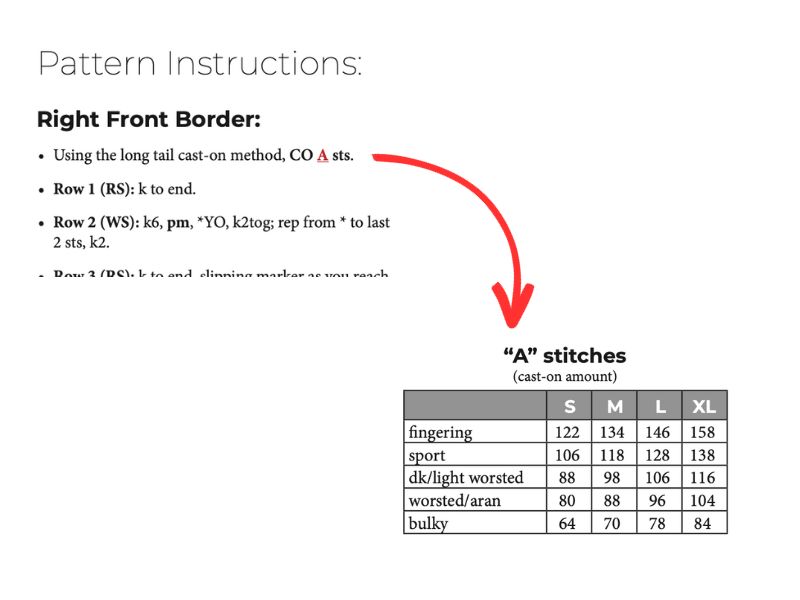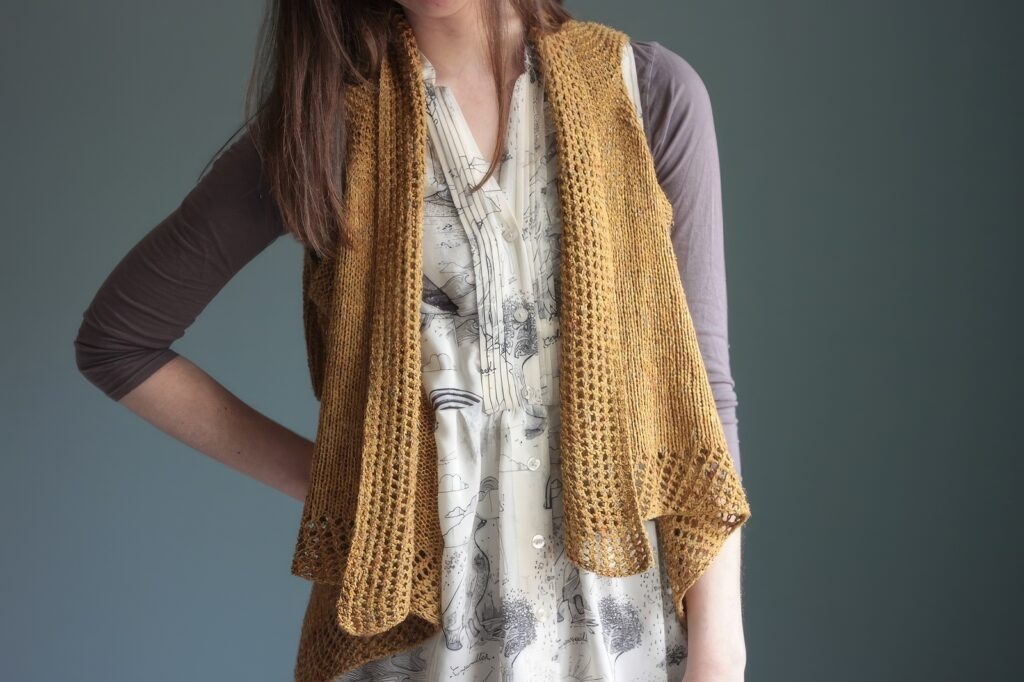Penny Tips
On this page you’ll find tips and tutorials for the techniques used in the Penny Vest. This page reviews the following techniques:
- Picking a size (and how to make it longer if you would like)
- Tips on reading the pattern
- Long-tail cast-on
- Working YO, k2tog (or k2tog, YO)
- Binding-off in the middle of your work
- Using cable cast-on to cast-on in the middle of your work
Picking a size (and how to make it longer if you would like)
There are 4 possible sizes to pick from in Penny: S, M, L and XL. However, you shouldn’t view these size labels in the traditional way (i.e, a medium is not like a medium you would buy in-store). Each of these sizes is meant to fit a wide range of bust sizes, as noted in the pattern and I’ve also noted it below:
- Size Small = fits busts 30-36″
- Size Medium = fits busts 38-44″
- Size Large = fit busts 46-52″
- Size X-Large = fit busts 54-60″
However, because the crossback measurement (this is your back width measurement across your shoulders) is the most important measurement in terms of fit, it’s also a good idea to measure your own crossback and compare it to the crossback measurement in the schematic. This measurement is listed as: 13 (14.5, 16, 17.5)”. Your own crossback measurement should be 1-2″ less than that of the garment. So if you are in-between sizes, or you have a larger bust but small shoulders, you may want to size down based on your crossback.
Note: when measuring your own crossback, do not go center of underarm to center of underarm – you want to measure just over your back and not include your underarm area.
How to Make your Penny Longer in the Back
One alteration I often get asked about is how to make your Penny longer in the back. Here are tips to do this:
- For your “A” number, cast-on for 1 size larger than you wanted to make.
- For all lengths listed in the pattern, follow instructions for the size you wanted to make.
- Your “B” number remains unchanged since it’s not dependent on size (just yarn-weight version).
- For “C”, use the number for 1 size larger than you were planning to make.
- For “D”, use the number for the size you wanted to make.
- For “E”, use the number for the size you wanted to make.
Tips on reading the pattern
Because Penny’s instructions allow for 5 different yarn-weights (fingering, sport, dk/light worsted, worsted/aran, or bulky), it’s written a little differently than my other patterns. As page 2 explains, all yarn-weights will follow the same instructions (which begin on page 3). The only variables are the stitch counts in 5 areas of the pattern, listed as A, B, C, D & E in the instructions (in red & underlined and defined in the tables on page 2).
So for example, as you can see in the screenshot below, the pattern says to CO (cast-on) “A” sts. To figure out what “A” means to you, look at the “A” table on page 2 and find the cell in the table that correlates with your chosen yarn-weight and your chosen size. So for example, if you were following the sport-weight instructions and making a size M, the you would cast-on 118 sts.

Long-tail Cast-On
I like to use the long-tail cast-on as my preferred cast-on method. Click here for my tutorial page on this cast-on technique. However, if you have a different preferred cast-on method you can feel free to use that.
Working YO, k2tog (or k2tog, YO)
The eyelet stitch pattern that is featured at each Front edge and along the top of the garment is created by working a YO followed by a k2tog on one side of the garment, and a k2tog followed by a YO on the other side of the garment. The reason for this is so that each side can mirror each other (since this stitch pattern will create a slant).
To work a YO, k2tog (or vice versa), you can refer to my video tutorial below where I explain how to work a YO, and at around the 1:00 mark I also show how to work a k2tog after a YO which may be helpful for this pattern.
Binding-off in the middle of your work
Your armholes in Penny are created by first binding-off stitches on “armhole row 1” and then casting-on stitches on “armhole row 2”. My video tutorial below walks you through how you go about binding-off in the middle of your row like you do in Penny:
Using cable cast-on to cast-on in the middle of your work
On the second armhole row, you’re instructed to use the cable cast-on method to cast-on stitches – this is how you create the other side of the armhole. Please note: you’ll notice that you are instructed to cast-on 1 extra stitch than was bound-off. This is because you work a decrease after the stitches have been cast-on (so you need that extra stitch). Below is my video tutorial that walks you through how to work the cable cast-on:

